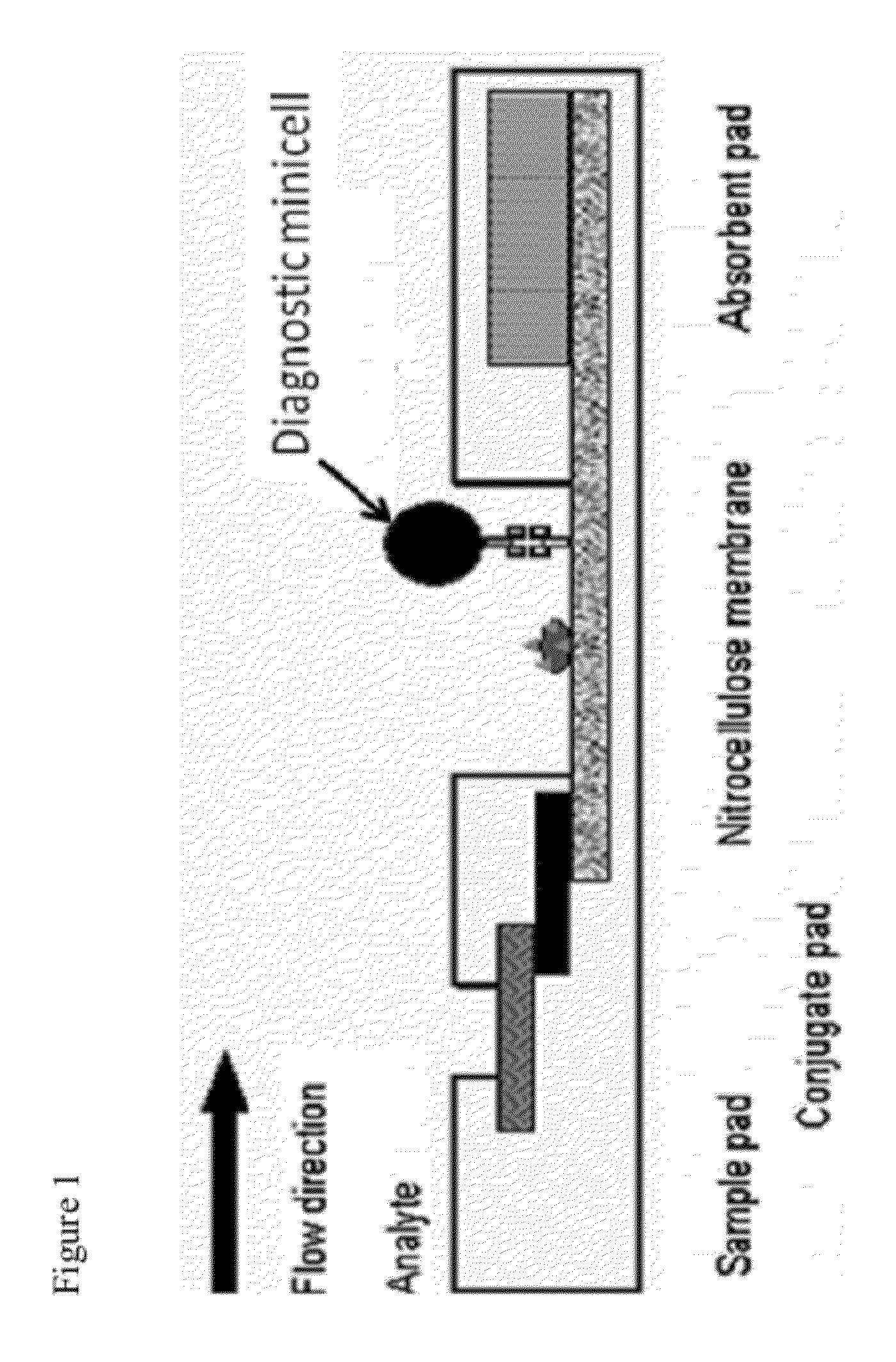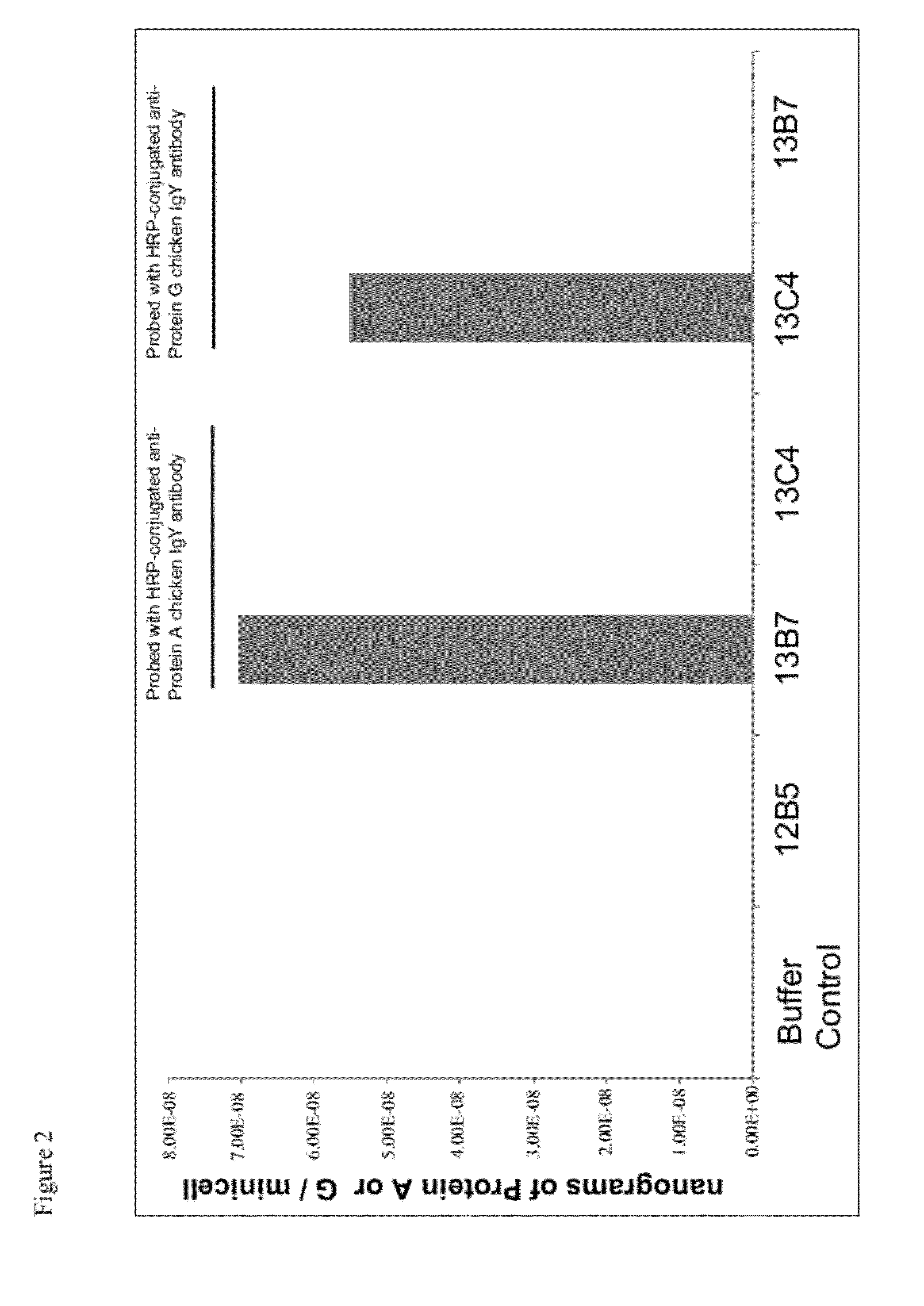Therapeutic compositions and methods for antibody and fc-containing targeting molecule-based targeted delivery of bioactive molecules by bacterial minicells
- Summary
- Abstract
- Description
- Claims
- Application Information
AI Technical Summary
Benefits of technology
Problems solved by technology
Method used
Image
Examples
example 1
[0192]Expression and display of the Fc binding region of Protein A or Protein G on the surface of minicells demonstrated by enzyme linked immunoabsorbent assay (ELISA). Minicell-producing E. coli strain VAX12B4 was transformed with either (i) the L-rhamnose inducible expression plasmid pVX-119 (codes for Lpp-OmpAΩProtein A; SEQ ID NO:1), (ii) the L-rhamnose inducible expression plasmid pVX-120 (codes for Lpp-OmpAΩProtein G; SEQ ID NO:2) or (iii) with an empty vector control plasmid, to create minicell-producing strains VAX13B7 (Protein A), VAX13C4 (Protein G), and VAX12C4 (vector control), respectively. Each of VAX13B7, VAX13C4, and VAX12C4 were grown overnight in 20 mL of Luria-Bertani (LB) broth containing 0.2% glucose, 10 mg / mL diaminopimelic acid (DAP), 11 mg / mL lysine and 50 mg / mL Kanamycin. The following day, each strain was independently subcultured by a 1 / 100 dilution of the overnight culture into 700 mL of fresh LB broth containing DAP, lysine and kanamycin, as above. Cultu...
example 2
[0194]Binding and display of VEGFR2 antibody by miniciells expressing the Fc binding portion of Protein A or Protein G. Minicells (1e09) purified from strain VAX13B7 (Protein A-displaying), VAX13C4 (Protein G-displaying), and VAX12B5 (negative control) were incubated with 1 microgram each without (−) or with (+) a mouse monoclonal IgG antibody against human VEGFR2 for 1 hour at room temperature to allow antibodies to bind to the minicells. After incubation, minicells were washed three times each with 1 mL of PBS (pH 7.4) to remove any unbound antibody. Minicells (1e08) were then analyzed by Western blot using an HRP-conjugated rabbit anti-mouse polyclonal antibody as the secondary antibody. The Western Blot is shown in FIG. 3. Specific binding of the secondary antibody was visualized using an Amersham ECL Detection Kit (GE Healthcare). Mouse anti-VEGFR2 antibody (100 ng) was loaded as a positive control (lane after 12B5).
[0195]FIG. 3 shows that the Fc region of the HRP-conjugated ra...
example 3
[0196]Binding and display of EGFR1 antibody by miniciells expressing the Fc binding portion of Protein A or Protein G. Minicells (1e09) purified from strain VAX13B7 (Protein A-displaying), VAX13C4 (Protein G-displaying), and VAX12B5 (negative control) were incubated with 1 microgram each without (−) or with (+) a mouse monoclonal IgG antibody against human EGFR1 (mAb528) for 1 hour at room temperature to allow antibodies to bind to the minicells. After incubation, minicells were washed three times each with 1 mL of PBS (pH 7.4) to remove any unbound antibody. Minicells (1e08) were then analyzed by Western blot using an HRP-conjugated rabbit anti-mouse polyclonal antibody as the secondary antibody. The Western Blot is shown in FIG. 4. Specific binding of the secondary antibody was visualized using an Amersham ECL Detection Kit (GE Healthcare). Mouse anti-EGFR antibody (100 ng) was loaded as a positive control (lane after 12B5).
[0197]As shown in FIG. 4, the Fc region of the HRP-conjug...
PUM
| Property | Measurement | Unit |
|---|---|---|
| Composition | aaaaa | aaaaa |
| Surface | aaaaa | aaaaa |
| Therapeutic | aaaaa | aaaaa |
Abstract
Description
Claims
Application Information
 Login to View More
Login to View More - Generate Ideas
- Intellectual Property
- Life Sciences
- Materials
- Tech Scout
- Unparalleled Data Quality
- Higher Quality Content
- 60% Fewer Hallucinations
Browse by: Latest US Patents, China's latest patents, Technical Efficacy Thesaurus, Application Domain, Technology Topic, Popular Technical Reports.
© 2025 PatSnap. All rights reserved.Legal|Privacy policy|Modern Slavery Act Transparency Statement|Sitemap|About US| Contact US: help@patsnap.com



